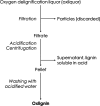Oxlignin: A Novel Type of Technical Lignin from Kraft Pulp Mills
- PMID: 40385208
- PMCID: PMC12079255
- DOI: 10.1021/acsomega.5c00434
Oxlignin: A Novel Type of Technical Lignin from Kraft Pulp Mills
Abstract
Lignin, a bio-originated polymer, is being explored as an alternative to nonrenewable fossil resources. It is obtained from biomass during pulping and is mostly burned for energy. In most kraft pulp lines, residual lignin in the pulp is oxidized and solubilized during an oxygen delignification step. This study proposes an isolation method for lignin solubilized during oxygen delignification, which we refer to as "oxlignin", and explores its structural characteristics and properties. The study found acid precipitation to be an effective method for partially isolating oxlignin from the oxygen delignification step. Various analytical methods were employed, including UV-vis absorption analysis, 31P NMR spectroscopy, FT-IR spectroscopy, SEC, and TGA. In addition, the solubility of the lignin was studied in four different solvents and compared to the commercial kraft lignins. The study found that oxlignin is a promising substitute for lignosulfonates in certain applications due to its hydrophilicity and high solubility in water, methanol, and ethanol. Compared to kraft lignins, oxlignin has a lower phenolic group content but higher carboxylic acid content.
© 2025 The Authors. Published by American Chemical Society.
Conflict of interest statement
The authors declare no competing financial interest.
Figures










Similar articles
-
Lignin modification during Eucalyptus globulus kraft pulping followed by totally chlorine-free bleaching: a two-dimensional nuclear magnetic resonance, Fourier transform infrared, and pyrolysis-gas chromatography/mass spectrometry study.J Agric Food Chem. 2007 May 2;55(9):3477-90. doi: 10.1021/jf063728t. Epub 2007 Apr 4. J Agric Food Chem. 2007. PMID: 17407317
-
Relationship between lignin structure and delignification degree in Pinus pinaster kraft pulps.Bioresour Technol. 2008 May;99(7):2349-56. doi: 10.1016/j.biortech.2007.05.012. Epub 2007 Jun 28. Bioresour Technol. 2008. PMID: 17604620
-
Effect of Residual Lignin Type and Amount on Bleaching of Kraft Pulp by Trametes versicolor.Appl Environ Microbiol. 1994 May;60(5):1395-400. doi: 10.1128/aem.60.5.1395-1400.1994. Appl Environ Microbiol. 1994. PMID: 16349246 Free PMC article.
-
About Making Lignin Great Again-Some Lessons From the Past.Front Chem. 2019 Aug 29;7:565. doi: 10.3389/fchem.2019.00565. eCollection 2019. Front Chem. 2019. PMID: 31555636 Free PMC article. Review.
-
Production and Application of Lignosulfonates and Sulfonated Lignin.ChemSusChem. 2017 May 9;10(9):1861-1877. doi: 10.1002/cssc.201700082. Epub 2017 Apr 11. ChemSusChem. 2017. PMID: 28253428 Review.
References
-
- Mboowa D. A review of the traditional pulping methods and the recent improvements in the pulping processes. Biomass Convers. Biorefin. 2024, 14 (1), 1–12. 10.1007/s13399-020-01243-6. - DOI
-
- Gierer J. Chemical aspects of kraft pulping. Wood Sci. Technol. 1980, 14 (4), 241–266. 10.1007/BF00383453. - DOI
-
- Sixta H.; Potthast A.; Krotschek A. W.. Chemical pulping processes. In Handbook of Pulp, 2006; .10.1002/9783527619887. - DOI
-
- Ulmgren P. Non-process elements in a bleached kraft pulp mill with a high degree of system closure - state of the art. Nord. Pulp Pap. Res. J. 1997, 12 (1), 32–41. 10.3183/npprj-1997-12-01-p032-041. - DOI
-
- Holmqvist A.; Wallberg O.; Jönsson A. S. Ultrafiltration of Kraft Black Liquor from Two Swedish Pulp Mills. Chem. Eng. Res. Des. 2005, 83 (8), 994–999. 10.1205/cherd.04204. - DOI
LinkOut - more resources
Full Text Sources
